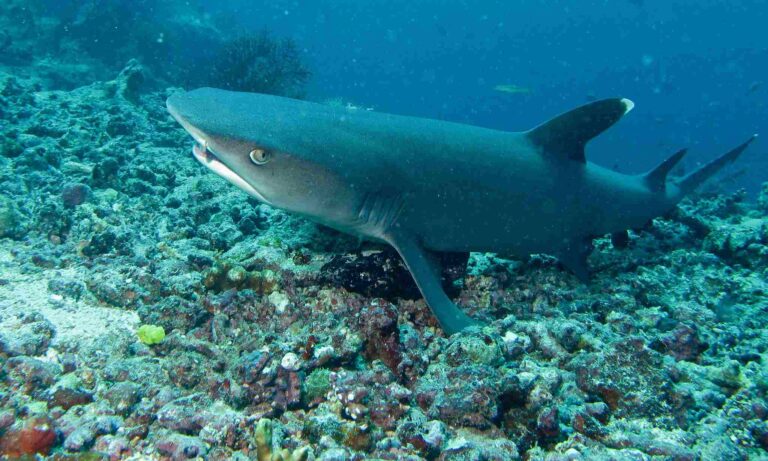7 Abiotic Factors in The Ocean Ecosystem and Their Characteristics
Abiotic factors in the ocean ecosystem are; temperature, solar intensity, sediments and soil, pH, acidity and salinity; and nutrients.
In total, the above-listed are seven (7) in number, where pH, acidity and salinity are considered distinct factors respectively (while sediments and soil are considered fundamentally identical).
Water is also an important abiotic factor in the ocean, but it is often omitted from discussions of the subject because it is the ambient medium of aquatic ecosystems.
Marine abiotic factors are the complementary opposite of biotic factors in ocean ecosystems, which are organic and include primary producers, herbivores, carnivores, omnivores, decomposers and biotic processes.
This article discusses abiotic factors in the ocean ecosystem, and their characteristics, as follows;
1). Temperature (as one of the Abiotic Factors in the Ocean Ecosystem)
Temperature is an abiotic factor in the ocean because it is an inorganic parameter that affects the physicochemical conditions of the ecosystem; and is neither organic in its origin nor solely dependent on biotic factors.
Basically, temperature determines how hot or cold a biological organism, ecologic medium or environmental system is at any given point in time.
Temperature is one of the most influential abiotic factors in the ocean, with its influence spanning from living organisms and metabolic processes to chemical reactions and physical conditions [1].
In all aquatic ecosystems (including non-saltwater biomes like ponds and lakes) temperature plays a key role in energy transfer; not only for thermal energy itself, but for other energy forms (including renewable marine energies) as well, like bioenergy, tidal, wave, and ocean thermal energies respectively.
Temperature varies in the ocean, under the influence of a variety of factors that include depth, season, water-current trends, and biochemical conditions. In turn, ocean temperatures affect the distribution of marine plants and animals with depth and area, while also influencing the trend of physical and biological processes like wave propagation and biodegradation.
Oceanic or marine temperature gradient describes the progressive change in temperature with marine depth, so that surface water in the ocean is generally of higher temperature than water at greater depth.
Because water is conductive and heat-absorbent, it acts as a natural energy storage system for solar heat, which can be exploited by humans, using technological equipment like OTEC converters, for any of various purposes including electricity generation.
The temperature gradient is important to the sustainability of oceans because it influences the distribution, metabolism, reproduction, adaptation and migration of species; and thereby also affects marine food chains and energy pyramids.
This explains why thermal pollution has very harmful effects on oceans, and causes decline in species richness and biodiversity of water bodies close to power plants and other potential-sources of excessive heat [3].
Temperature also influences the trend of ocean currents by altering water density, so that a natural, convective dynamic is usually established where warm water continuously rises above colder water-masses.
Studies of ocean temperature often make reference to other abiotic physicochemical parameters of the ocean like pH and salinity.
2). Solar Intensity
Solar intensity in the ocean is evaluated in terms of heat and light (that is; sunlight).
Marine solar intensity can be described as the amount of electromagnetic radiation from the Sun that is entering into an ocean at any given time.
Sunlight is an abiotic factor in the ocean because its source, sustenance and influence are not organic in nature, but rather come ultimately from nuclear fusion reactions, which are made up of inorganic reactants and products. This goes contrary to the attributes of biotic factors, that are derived mostly from organic sources and processes.
The sun heating the ocean is an abiotic process because it involves the propagation and absorption of infrared radiation from the Sun (which is inorganic), and the physical changes in temperature, kinetic energy and phase, which accompany this propagation and absorption.
Solar radiation is arguably the most important and influential abiotic factor in the ocean, because it is the ultimate source of energy used by marine producers for photosynthesis, and it tends to affect all other abiotic factors including salinity, temperature and ocean currents.
The intensity and depth of solar radiation determines which organisms will survive and their respective locations, in a given marine ecosystem.
Solar radiation is also used to analyze the structure of the ocean, and to identify various zones like euphotic and aphotic zones, which have varying levels of solar intensity.

3). Sediments and Soil (as one of the Abiotic Factors in the Ocean Ecosystem)
Sediments and soil materials like sand constitute an abiotic factor or component in the ocean, because these materials are inorganic in nature.
There are many varying opinions on the place of sedimentary materials in oceans. This is because of the close relationship between ocean sediments and biotic factors like living organisms and biological processes.
Several marine organisms are bottom-dwellers that live in constant contact with the seabed sediments [4], while some are detrivores that feed on detritus, in the sediments.
The categorization of sediments and soil as abiotic factors comes also from the fact that most inorganic nutrients in the ocean are contained in sediments, which play a central role in the conservation, recycling and distribution of these nutrients.
Sand is a common type of sedimentary soil material in ocean ecosystems because the active weathering and erosional activities of marine waves results in large amounts of sand particles that often extend from seabed and continental shelf to the entire coast.
However, there are other marine sediments and soil materials asides sand; such as silt, clay, and humus.
Ocean sediments help in carbon sequestration, which is the process that enables oceans to function as carbon sinks. Importance of sediments and soils in the ocean can be attributed to their role carbon and oxygen cycles, as well as their usefulness as nutrient-sources and natural habitat to various aquatic organisms.

4). pH, Acidity and Salinity
pH, acidity and salinity are very important and interrelated abiotic factors in the ocean, each of which is known to have significant impact on the conditions of marine ecosystems.
pH is an abiotic factor that estimates the degree of acidity or alkalinity of a given solution or medium, by assessing hydrogen-ion concentration. The pH of ocean water affects physicochemical and biological conditions.
It (marine pH) is measured on a range from 0 to 14, where the degree of acidity decreases with increase in value, and alkalinity increases with increase in pH value [5].
Acidity is a measure of the concentration of hydrogen ions in a medium or solution. It is closely linked to pH, so that both concepts are sometimes used interchangeably to represent each other.
Ocean acidity is different from ocean acidification; which is a process whereby the pH of saltwater in oceans decreases due to excessive absorption of carbon dioxide (CO2) [2].
Ocean acidification involves the formation of carbonic acid as seawater reacts with carbon dioxide; in a mechanism similar to that behind acid rain formation. Its impacts on marine organisms include reef and shell-formation difficulties, due to carbonate dissolution by acidic seawater.
Abiotic factors that play roles in ocean acidification include pH, salinity, initial acidity, CO2 concentration, oxygen concentration, and temperature.
Salinity is a marine abiotic factor that measures the concentration of salts (especially sodium chloride) occurring in seawater as solute. Its units include practical salinity unit (PSU)/grams of salt per kilogram of water, parts per million (ppm), and parts per thousand (ppt).
Factors that determine ocean salinity include temperature, evaporation (which is often influenced by temperature), water-recharge rate (from precipitation and adjacent water bodies), and rate of water-mixing.
Salinity of the ocean affects its biotic and abiotic conditions, such as organic survivability, water freezing-point, electrical conductivity and density.

5). Nutrients and their Recycling (as one of the Abiotic Factors in the Ocean Ecosystem)
Nutrients and the process of their recycling, constitute one of the abiotic factors in the ocean ecosystem.
Ocean nutrients include chemical elements and their compounds, which form part of the composition of marine water, sediments, and/or organisms.
Examples of nutrients in the ocean are carbon (C), phosphorus (P), potassium (K) and nitrogen (N).
Sources of ocean nutrients include organic decomposition and stormwater runoff.
The recycling of these nutrients is driven by organic and inorganic processes of nutrient-consumption, waste production and re-assimilation.
Conclusion
Abiotic factors in the ocean ecosystem are;
1. Temperature
2. Solar Intensity
3. Sediments and Soil
4. pH, Acidity and Salinity
5. Nutrients and their Recycling
References
1). Bruno, J. F.; Carr, L. A.; O'Connor, M. I. (2015). "Exploring the role of temperature in the ocean through metabolic scaling." Ecology. 2015 Dec;96(12):3126-40. Available at: https://doi.org/10.1890/14-1954.1. (Accessed 21 May 2023).
2). Findlay, H. S.; Turley, C. M. (2021). "Ocean acidification and climate change." Climate Change (pp.251-279). Available at: https://doi.org/10.1016/B978-0-12-821575-3.00013-X. (Accessed 21 May 2023).
3). Jin, Y.; Behrens, P.; Tukker, A.; Scherer, L. (2022). "Biodiversity Loss from Freshwater Use for China's Electricity Generation." Environ Sci Technol. 2022 Mar 1;56(5):3277-3287. Available at: https://doi.org/10.1021/acs.est.1c07155. (Accessed 21 May 2023).
4). Pan, J.; Pratolongo, D. (2021). "Soft-bottom Marine Benthos." Marine Biology A Functional Approach to the Oceans and their Organisms (pp.180-210). Available at: https://doi.org/10.1201/9780429399244-10. (Accessed 21 May 2023).
5). Wood, H. L.; Spicer, J. I.; Widdicombe, S. "Ocean acidification may increase calcification rates, but at a cost." Proc Biol Sci. 2008 Aug 7;275(1644):1767-73. Available at: https://doi.org/10.1098/rspb.2008.0343. (Accessed 21 May 2023).




